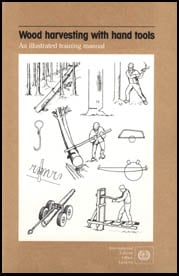
Introduction[edit | edit source]
This training manual updates and amalgamates the following previous ILO publications:
- Felling and cross-cutting of tropical trees in natural forests (1969); and
- Selection and maintenance of logging hand tools (1970).
These publications were prepared by B. Strehlke, on the basis of substantial inputs from H. Gl�ser and R. Wettstein and with illustrations by B. Schmidle. The first of these two publications dealt with axes, hand saws and chain saws. Its English version has been out of print for several years. In 1980, in collaboration with the FAO, the section dealing with chain saws was expanded to include work in man-made forests and chain-saw maintenance and this was published separately under the title:
- Chainsaws in tropical forests (Rome, FAO/ILO, 1980).
During the last decade, the use of chain saws has spread increasingly to the developing countries where they are found in commercial logging operations, especially in countries with higher wage levels. However, wood harvesting with manual tools continues on a large scale and, with the shift of emphasis to trees grown by rural people, it will gain more importance in the years to come.
It is for this reason that a need was felt to compile information on basic wood harvesting, excluding machines and techniques which in many developing countries are out of reach of the rural population. This view was fully supported by the participants in an FAO/ECE/ILO Workshop on the Transfer of Basic Technology, held in 1986.
For several years it looked as if experience in efficient basic logging and supplies of hand tools of adequate quality would become less and less available. This trend has changed thanks to the manufacture of improved forestry tools in several developing countries and the reappearance of logging hand tools in the catalogues of some of the major dealers in forestry tools and equipment.
Attempts have also been made in Central Europe and Scandinavia to keep alive experience in manual logging accumulated in previous periods and to encourage further improvement of manual tools and techniques. An example of this is the logging sulky of which a bogie type has been developed only recently.
This manual is addressed primarily to trainers, extension workers, work supervisors and foremen.
As in the three publications mentioned above, an attempt has been made to use simple terms and to describe as much as possible by means of drawings. Users are encouraged to translate the text into other languages and to copy illustrations in any way they might find useful for training purposes.
The reader interested in supplementary information is referred to the following publications:
- Equipment planning guides for vocational and technical training and education programmes: No. 17 - Forestry (Geneva, ILO, 1981);
- Basic technology in forest operations (Rome, FAO, 1982);
- Swedish forestry techniques with possible applications in the Third World (Sp�nga, SIDA, 1983);
- Handbook on appropriate technology for forestry operations in developing countries (Helsinki, FINNIDA, 1986).
The present publication was compiled by B. Strehlke in collaboration with E. Fosser. Hazel Cecconi edited and typed the text and Michel Bag�s amended and supplemented the drawings. DANIDA provided the finance.